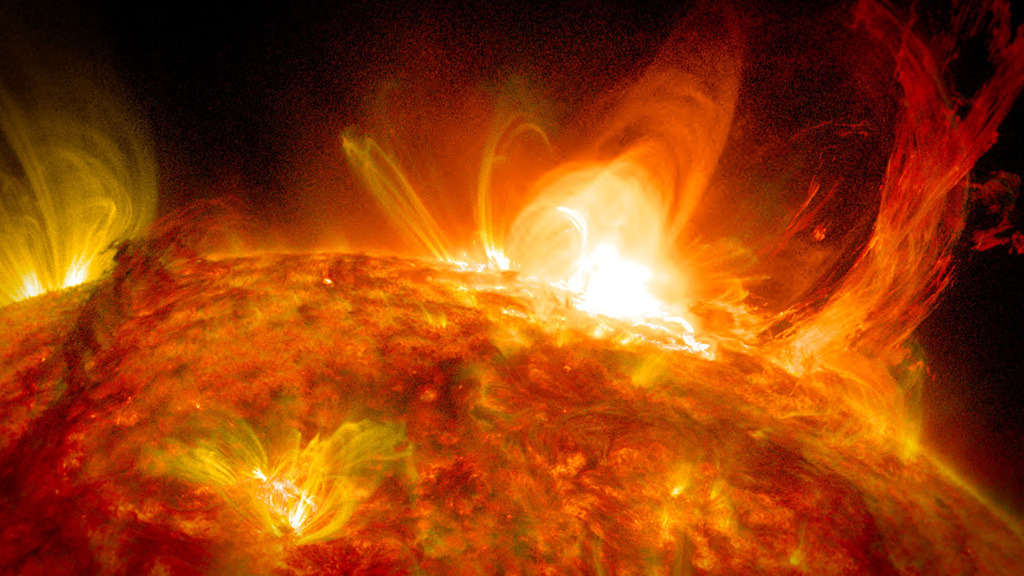Sun Emits Mid-Level Flare on October 2, 2014
The sun emitted a mid-level solar flare, peaking at 3:01 p.m. EDT on Oct. 2, 2014. NASA's Solar Dynamics Observatory, which watches the sun 24-hours a day, captured images of the flare. Solar flares are powerful bursts of radiation. Harmful radiation from a flare cannot pass through Earth's atmosphere to physically affect humans on the ground, however — when intense enough — they can disturb the atmosphere in the layer where GPS and communications signals travel.
This flare is classified as an M7.3 flare. M-class flares are one-tenth as powerful as the most powerful flares, which are designated X-class flares.
Video of flare and eruption in several wavelengths. It begins with 304 angstrom, then 171, and finally a blend of 304, 171 and 131, which shows the hottest flaring regions.
Music: "No Comment Before Sunset" by Lars Leonhard, courtesy of the artist and BineMusic.
Watch this video on the NASA Goddard YouTube channel.
For complete transcript, click here.

NASA's Solar Dynamics Observatory captured this image of a solar flare on Oct. 2, 2014. The solar flare is the bright flash of light on the right limb of the sun. A burst of solar material erupting out into space can be seen just below it. Full 4k full-disk view.
Image Credit:
NASA/SDO

NASA's Solar Dynamics Observatory captured this image of a solar flare on Oct. 2, 2014. The solar flare is the bright flash of light on the right limb of the sun. A burst of solar material erupting out into space can be seen just below it.
Image Credit:
NASA/SDO
4k frames and video covering a time period of 16:30 UT to 21:30 UT. 304 angstrom wavelength extreme ultraviolet light.
Credit: NASA/SDO
4k frames and video covering a time period of 16:30 UT to 21:30 UT. 171 angstrom wavelength extreme ultraviolet light.
Credit: NASA/SDO
4k frames and video covering a time period of 16:30 UT to 21:30 UT. 131 angstrom wavelength extreme ultraviolet light.
Credit: NASA/SDO
For More Information
Credits
Please give credit for this item to:
NASA's Goddard Space Flight Center
-
Animator
- Tom Bridgman (Global Science and Technology, Inc.)
-
Video editor
- Scott Wiessinger (USRA)
-
Producer
- Scott Wiessinger (USRA)
-
Writer
- Karen Fox (ADNET Systems, Inc.)
Release date
This page was originally published on Friday, October 3, 2014.
This page was last updated on Wednesday, May 3, 2023 at 1:50 PM EDT.
Missions
This page is related to the following missions:Series
This page can be found in the following series:Tapes
The media on this page originally appeared on the following tapes:-
2014 Heliophysics Breaking News
(ID: 2014015)
Tuesday, December 30, 2014 at 5:00AM
Produced by - Robert Crippen (NASA)
Datasets used
-
[SDO]
ID: 168This dataset can be found at: http://sdo.gsfc.nasa.gov/
See all pages that use this dataset -
AIA 304 (304 Filter) [SDO: AIA]
ID: 677This dataset can be found at: http://jsoc.stanford.edu/
See all pages that use this dataset -
AIA 171 (171 Filter) [SDO: AIA]
ID: 680This dataset can be found at: http://jsoc.stanford.edu/
See all pages that use this dataset -
AIA 131 (131 Filter) [SDO: AIA]
ID: 730This dataset can be found at: http://jsoc.stanford.edu/
See all pages that use this dataset
Note: While we identify the data sets used on this page, we do not store any further details, nor the data sets themselves on our site.

